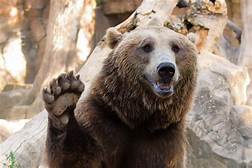Can You Get a Bear as a Pet?
Bears are often seen as wild and dangerous animals, but some people may wonder if it is possible to keep one as a pet. The answer is technically yes, but it is important to understand the challenges and responsibilities involved before making such a decision.

Bear Species
There are many different species of bears, each with its unique characteristics and habitat. Some of the most common species include:
1. American Black Bear: This is the most common bear species in North America and is found in forests and mountainous regions.
2. Brown Bear: Brown bears are found in various parts of the world, including North America, Europe, and Asia. They are larger than black bears and can be more aggressive.
3. Grizzly Bear: Grizzly bears are a subspecies of brown bears found in North America. They are known for their size and strength.
Legality and Regulations
The legality of keeping a bear as a pet varies by country and state. In some areas, it is illegal to own a bear, while in others, it may be permitted with a special license or permit. It is important to check local laws and regulations before considering getting a bear as a pet.
Captive Breeding and Care
Bears that are bred in captivity may be more suitable as pets than wild bears. They are accustomed to human interaction and may be easier to train and socialize. However, it is important to note that even captive-bred bears can still be unpredictable and may exhibit wild behaviors.
Providing proper care for a bear is essential. They require a spacious enclosure that allows them to move freely and engage in natural behaviors. The enclosure should also be secure to prevent escape and protect the bear from potential harm.
Bears have specific dietary needs and require a balanced diet that includes fruits, vegetables, meat, and fish. Access to clean water is also crucial for their health.
Behavioral Challenges
Bears are wild animals, and even those bred in captivity may exhibit unpredictable behaviors. They can be destructive, aggressive, and territorial. Training and socialization can help mitigate these behaviors, but it is important to understand that bears are not domesticated animals and may never be fully tame.
Bears can also pose a danger to humans. They have sharp teeth and claws and can inflict serious injuries. Proper handling and safety precautions are necessary to minimize the risk of accidents.
Alternatives to Bear Ownership
If you are interested in bears but are unsure about the challenges of owning one, there are several alternatives to consider:
1. Volunteering at a Bear Sanctuary: You can contribute to the care and well-being of bears by volunteering at a sanctuary or rescue organization.
2. Wildlife Photography: Capturing images of bears in their natural habitat can be a rewarding and educational experience.
3. Bear Watching: Participating in guided bear-watching tours or visiting areas where bears are known to live can be a thrilling and safe way to observe these amazing animals.
Conclusion: Keeping a bear as a pet is not a decision to be taken lightly. It requires a deep understanding of bear behavior, extensive resources, and a commitment to providing the best possible care. Most experts advise against keeping bears as pets due to the risks and challenges involved. Instead, exploring alternative ways to appreciate and learn about bears is a safer and more ethical approach.
Declaration: All article resources on this website, unless otherwise specified or labeled, are collected from online resources. If the content on this website infringes on the legitimate rights and interests of the original author, you can contact this website to delete it.






